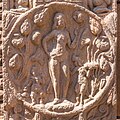Pompeii Lakshmi
| Pompeii Yakshi | |
|---|---|
 An ivory statuette of Lakshmi (1st century CE), found in the ruins of Pompeii | |
| Material | Ivory |
| Height | 24.5 cm (9+1⁄2 in) |
| Discovered | c. 1930–1938 Pompeii |
| Present location | Secret Museum, Naples, Italy |
| Identification | 149425 |
Location of Pompeii, where the Lakshmi statuette was excavated | |
The Pompeii Lakshmi is an ivory statuette that was discovered in the ruins of
Originally, it was thought that the statuette represented the goddess
The figure is now in the
Contents
The statuette was discovered in October 1938 beside the Casa dei Quattro stili at Pompeii.[2] Based on its architectural remains and floor plan, this "House of the Four Styles," directly off of the Via dell'Abbondanza, is now believed to have belonged to a successful merchant.[6] It is crammed with luxurious Indian commodities, suggesting that Romans in the first century CE had a fascination with antiquities not just from Greece but also from remote cultures, and that Romans had a desire to acquire objects they considered exotic.[6]
Standing at 0.25 metres (9.8 in), high the statuette is nearly naked apart from her narrow girdle and lavish jewels as well as an elaborate coiffure. She has two female attendants, one facing outward on each side, holding cosmetics containers.[3] The statuette has a hole bored down from the top of her head. There is the theory that its purpose may have been a mirror handle.[2]
The existence of this statuette in Pompeii by 79 CE, when Mount Vesuvius erupted and buried the city, testifies to the intensity of Indo-Roman trade relations during the 1st century CE.[3][7] This statuette has been dated by the Naples National Archaeological Museum as having been created in India in the first half of that century.[5]
-
The statuette upon discovery in Pompeii, before reconstitution.
-
The Pompeii Lakshmi, front and back.
-
Sides of the statuette.
Trade
Though the origin is not entirely certain, based on archeological finds and historian work, the Pompeii Lakshmi has had a questionable origin. There is evidence of the then active trade routes between the
There is a possibility that the statuette found its way to the west during the rule of
Rome played an important part in the Eastern oriental trade of antiquity, they imported many goods from India and at the same time set up their own trading stations in the country.[10] According to Cobb, trading through land routes such as crossing the Arabian Peninsula and Mesopotamia, and through seaborne trade from the Red Sea and the Indian Ocean were used by the Romans.[10]
The wealth of the trade was significant enough for Pliny to claim that 100 million sesterces were being sent annually to India, China, and Arabia.[10] With shipments of nard, ivory, and textiles it is clear from the archaeological evidence, that Roman trade with the East peaked in the first and second centuries CE.[10] This time period also witnessed a material shift among Roman craftsmanship, which rapidly began to favor imported ivory over traditional bone for use in furniture, musical instruments, accessories, and more.[11] The insatiable desire for artisan ivory work even led to the creation of a politically powerful guild of Roman ivory workers: the Eborarii.[11]
Origin

It was initially assumed that the statuette had been produced at
There is also an inscriptive mark in Kharosthi at the base of the Pompeii statuette (the letter śi, as the śi in Shiva).[12] This suggests she might have originated from the northwestern regions of India, Pakistan, or Afghanistan, or at least passed through these areas.[15] Since the Pompeii statuette was necessarily made sometime before 79 CE, if it was indeed manufactured in Gandhara, it would suggest that the Begram ivories are also of this early date, in the 1st century CE.[15]
Iconography
The statuette is represented in the round, and the center of two other female figures. The legs are turned to its side and one arm bent to hold earrings. She is presumed to only be looked at from the front because the details from the back are very flat. As stated by D’Ancona, the iconography falls into the broad category of female deities in India.[16]
In a case of cross-cultural pollination, the theme of the goddess attended by two child attendants, which can be seen in the case of the Pompeii Lakshmi, is an uncommon depiction of Lakshmi or Yashis in
-
Venus with cupid attendants.
-
Venus with cupid attendants.
-
Sanchi Stupa No.2, 115 BCE.
-
A woman, almost certainly Venus, reclines on a couch accompanied by two cupid attendants (reproduction)
See also
- Sator Square, discovered at Pompeii
References
- ^ JSTOR 3248502.
- ^ JSTOR 4340562.
- ^ ISBN 978-1847650641.
- ISBN 978-8170174165.
- ^ a b "Lakshmi". Museo Archeologico Napoli. Retrieved 4 February 2017.
- ^ ISSN0022-4995.
- ISBN 9780892369416.
- ^ S2CID 145360753.
- ISBN 978-9004185258.
- ^ S2CID 161205518.
- ^ ISSN0333-5844.
- ^ a b Statuetta eburnea di arte indiana a Pompei, Maiuri p. 112
- ^ ISBN 9788171548552.
- ISBN 978-9004185258.
- ^ a b Afghanistan: Forging Civilizations Along the Silk Road, Joan Aruz, Elisabetta Valtz Fino, Metropolitan Museum of Art, 2012 p. 75
- ISBN 978-0892369416.
- ^ "Imitation of a Statuette of a Female Reclining on a Couch with Erotes (The J. Paul Getty Museum Collection)". The J. Paul Getty Museum Collection. Retrieved 2022-04-24.
- ^ doi:10.1093/oxfordhb/9780199935390.013.128.
- ^ a b An Encyclopaedia of Indian Archaeology, by Amalananda Ghosh, Brill p. 295
External links
- Comparative images of Bhokardan, Ter and Pompeii statuettes in Pompeii Laxmi and Twin Sister from Bhokardan









